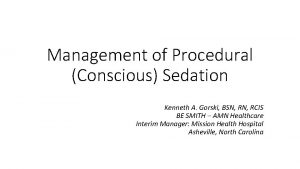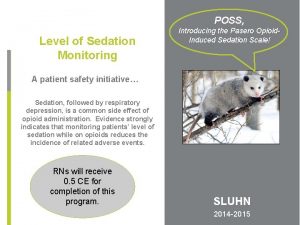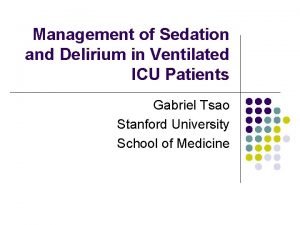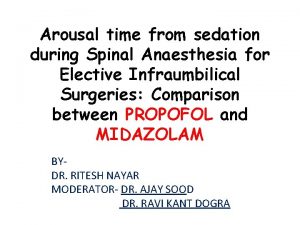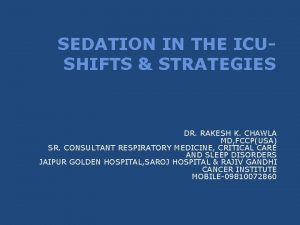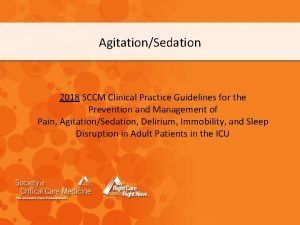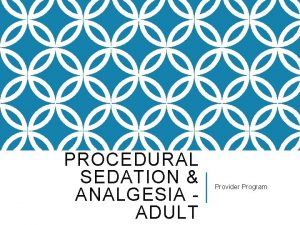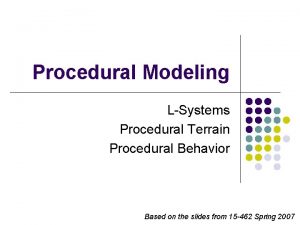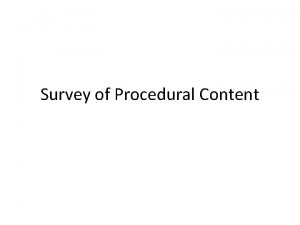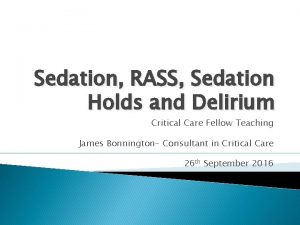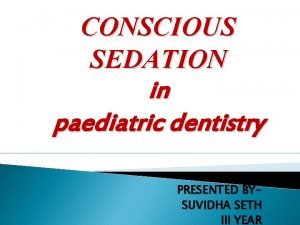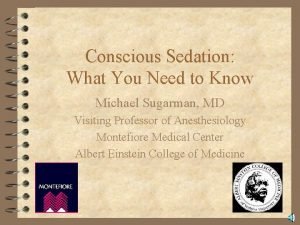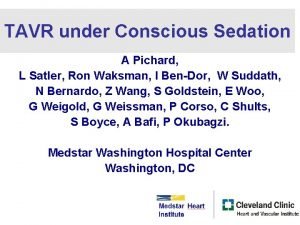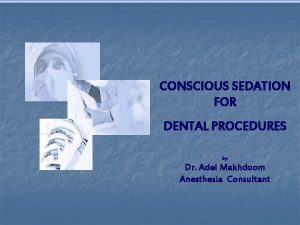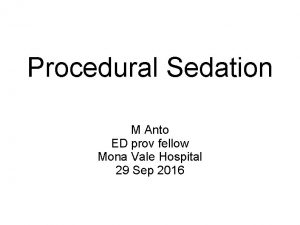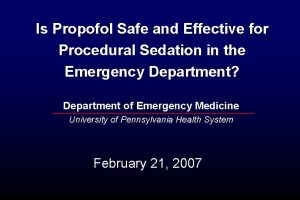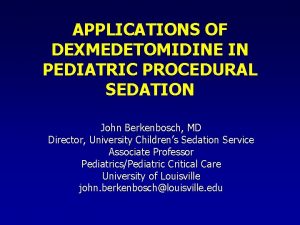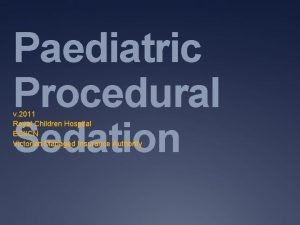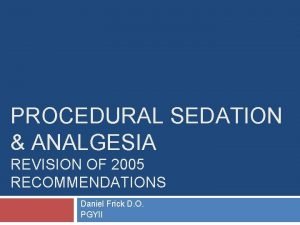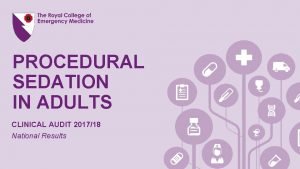Management of Procedural Conscious Sedation Kenneth A Gorski
























- Slides: 24

Management of Procedural (Conscious) Sedation Kenneth A. Gorski, BSN, RCIS BE SMITH – AMN Healthcare Interim Manager: Mission Health Hospital Asheville, North Carolina

Kenneth A. Gorski, BSN, RCIS I have no relevant financial relationships

Our patients are underdoing a procedure on their HEART - They fear the unknown - They do not want additional pain Our Goals: - Reduce Anxiety - Minimize Discomfort - No Negative/ill Effects

Cath Lab Sedation

Pain Free Dentistry

Difference Between Conscious and Unconscious Sedation (Posted in Sedation Dentistry) • In conscious sedation, the patient is given a sedative either orally or intravenously the puts the patient in a very relaxed and drowsy state. In some cases the patient may doze off, but the patient is always conscious. Conscious sedatives partially block memory formation so even if the patient was not actually asleep, it may seem that way since they have little or no memory of the procedure. • In unconscious sedation, general anesthesia is used to fully sedate the patient. The patient is unconscious throughout the procedure and cannot respond to questions or directions.

Yes, a man named Snow was the first to “Snow a patient” https: //www. slideshare. net/anaesthesiology-mgmcri/anesthesia-history-63732808

Cath Lab Sedation circa mid 1980 s Pre Procedure: 1. +/- Benadryl 25 -50 mg PO 2. +/- Valium 2. 5 -5 mg PO Intra Procedure 1. Morphine 5 mg IV 2. Valium 5 mg IV Patient monitored with NIBP and “Bouncing Ball” Monochrome Oscilloscope

Moderate Sedation Moderate (formerly Conscious) Sedation: minimally depressed, patient maintains patent airway independently, responds appropriately to physical stimulation and verbal commands

Deep Sedation: controlled state which the patient is not easily aroused, responds purposely to repeated or painful stimuli, may require assistance to maintain a patent airway, spontaneous ventilation may be impaired.

General Anesthesia: loss of consciousness, unable to arouse even with painfull stimuli, inability to maintain independent ventilation, requires assistance to maintain patent airway, cardiovascular function may be impaired.

Monitored Anesthesia Care (MAC) Monitored anesthesia care (MAC) has been described as a specific anesthesia service for diagnostic or therapeutic procedures performed under local anesthesia along with sedation and analgesia, titrated to a level that preserves spontaneous breathing and airway reflexes, according to the latest American Society of Anesthesiologists (ASA) update in 2008. [

In October 2014, the American Society of Anesthesiologists (ASA) Committee on Standards and Practice Parameters recommended new guidelines for moderate sedation to guide other medical practitioners and encourage education and training.

Monitor Requirements • The following monitors must be present, with appropriate alarm ranges turned on at all times: • Blood pressure • ECG • Pulse oximeter • End tidal CO 2 monitoring is recommended by the ASA

Limitations of Pulse Oximetry • Pulse-oximetry assess oxygenation, the amount of oxygen inhaled by the lungs that reaches the bloodstream • Measures how much of each red blood cell is bound with oxygen. • A normal SPO 2 is 92 -96%. • It does not provide a full picture of how well a patient is ventilating • It does not provide information on the cellular environment that can impact the uptake of oxygen.

Why Capnography? • Capnography assesses ventilation, air movement in and out of the lungs • Represents the amount of carbon dioxide (CO 2) in exhaled air • Assesses ventilation. • It consists of a number and a graph. The number is capnometry, which is the partial pressure of CO 2 detected at the end of exhalation, or End-tidal CO 2 • A normal ETCO 2) which is normally 35 -45 mm Hg.


Airway Management • Supplemental O 2 and accessories (nasal canula, simple mask, nonrebreather, etc. ) • Ambu bag • Continuous suction system with catheters • Emergency Airway Management supplies / Intubation Tray • Crash Cart with Resuscitation Meds

Reversal Agents • Narcan • Flumazenil

Most Commonly Used (United States) • Midazolam • • Benzodiazepine most commonly used Fast onset of sedation Amnesic effects less pain on injection and improved awakening compared with Valium • Fentanyl • Provide analgesia and sedation • Has been favored because of its prompt onset and short duration of action Fentanyl is a synthetic opioid pain reliever that, according to the CDC, is 50 to 100 times more potent than morphine.

Increasing public awareness/concern


Alternatives to Fentanyl • Midazolam only • Propofol • Ketamine • Procedural Doses typically used does not affect pharyngeal-laryngeal reflexes Patent airway and spontaneous respiration maintained • Particularly useful for emergency procedures when fasting is not assured. • Hallucinogenic effects

 Dr kenneth gorski
Dr kenneth gorski Poss scale
Poss scale Richmond agitation sedation scale
Richmond agitation sedation scale Richmond agitation sedation scale
Richmond agitation sedation scale Over-sedation
Over-sedation Rikers sedation scale
Rikers sedation scale Sédation
Sédation Sccm pad guidelines
Sccm pad guidelines Schemat lądolodu
Schemat lądolodu Gorski kotar i lika
Gorski kotar i lika Najvece naselje gorske hrvatske
Najvece naselje gorske hrvatske Ruza kasanova
Ruza kasanova Gorski krajevi rh ponavljanje
Gorski krajevi rh ponavljanje Opis krajobrazu
Opis krajobrazu Gorski kotare moj
Gorski kotare moj Ryan gorski
Ryan gorski Dimensions of classroom management
Dimensions of classroom management Kenneth rosen discrete mathematics pdf
Kenneth rosen discrete mathematics pdf Kenneth nelson sofi
Kenneth nelson sofi Kenneth lane thompson
Kenneth lane thompson Kenneth einar himma
Kenneth einar himma Atty. agustin patricio
Atty. agustin patricio Kenneth ott ecommerce
Kenneth ott ecommerce Dramatism of kenneth burke
Dramatism of kenneth burke Kenneth malmberg
Kenneth malmberg
